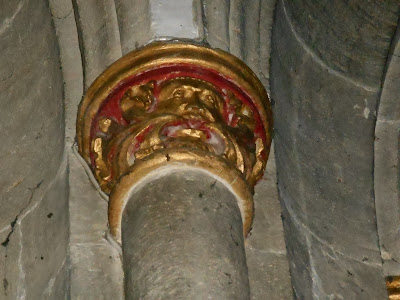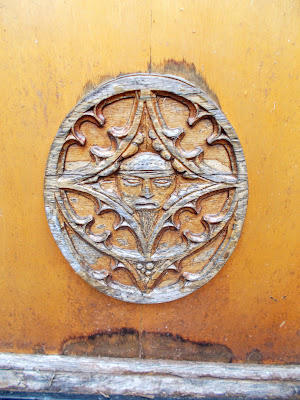The best definition I have found for the Green Man is the following by Clive Hicks in his book The Green Man: A Field Guide (published 2001):
"The Green Man is an image and an idea. It is the image of a human face associated with foliage and it is the idea that makes real the connection between humanity and nature. The image personifies the idea."
The earliest Green Men in Britain, probably arrived with the Normans but the majority of Green Man images are found carved in wood or stone in medieval churches and cathedrals. They are also found in some European countries, especially France and Germany.
The Green Man is also used as a name for a public house in England, although there are none in Somerset (the closest are in Barnstaple, Kings Stag (Dorset) and Bristol).
The term Green Man was first used by Lady Raglan in 1939. Before this time they were usually described as "foliate heads".
No medieval written records have been found about Green Men, so their original meaning is shrouded in mystery. They may have their origins in ancient mythology, which lives on today in folk customs, for example May Day celebrations, which sometimes include a character known as Jack-in-the-Green and have the theme of regeneration/rebirth. Alternatively their origins may lie with "wild-men" who lived in the woods on the fringes of society in the Middle Ages, for example Robin Hood. Or they could come from an innate part of the human psyche where the Green Man symbolises the realisation and acceptance that humanity and the world are inseparable.
There are three main types of Green Men:
- Have faces formed of leaves
- Have faces where foliage comes out of the face, usually the mouth but occasionally the nose, ears or eyes. This is the most common type in medieval carvings in England
- The face is set amongst the foliage.
There are a few theories as to why so many Green Men are found in British churches:
- They are a customary decoration
- They are a witness to the events of the Christian story: Nativity, Crucifixion, Last Judgment etc and the cycle of life
- They are there to teach us to behave better and to deter us from sinning
Somerset has more than its fair share of Green Men. Here are a few I have spotted:
Capital, St Andrew's Church, Banwell
St Nicholas's Church, Withycombe
































Very interesting, I'll have a look in my local church next time I'm passing.
ReplyDeleteHi, thanks for your work on this! It would also be worth popping in to Spaxton church (not Charlynch, although who knows!? Have to get the owner's permission though as it's private and deconsecrated) no, the one in Spaxton village, there appears to be one that has been defaced on a prominent aisle - as you go in go straight ahead and then look for it on your right. The style of the 'beard' doesn't match the rest of the carving. Also take a walk to Culbone church (St Bueno's??) Through the pretty tunnels along the coast path from Porlock Weir. When you get to the church ignore the door and instead walk around the back to somewhere near ///rephrase.slippers.shameless look for the really old window in the back wall of the church - at the top of it there is a cat with it's lower jaw missing. Not sure how well documented that one is. Allow all day for the walk and be careful of ticks if you go off the path. You can park where the arched entrance to the toll road is at ///mural.propelled.gears beautiful walk! Matt
ReplyDelete